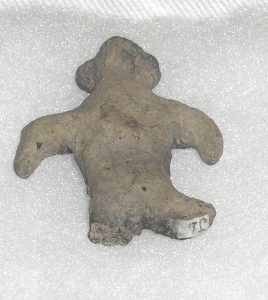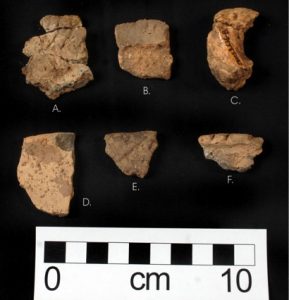The Earliest Occupants
Fort Osage was not the first human occupation along this portion of the Missouri River. Archaeological investigations have revealed that Native Americans occupied this locality much earlier, sometime around A.D. 400. This occupation was part of what archaeologists have termed “Kansas City Hopewell”. In fact, Native American occupation in this region probably goes back much further in time. Scattered artifacts found by artifact collectors in the general area around Fort Osage suggests that initial Native American occupation likely dates back at least 10,000 years.

There are two known Kansas City Hopewell sites in the Fort Osage Park. The Sibley Site was found in the 1960s by an amateur archaeologist, Claude Knoles. This site is an intensively occupied Hopewell village on river terrace remnants. An excavation was undertaken on the site by Knoles and the Kansas City Archaeological Society in the late 1960s. Another small excavation was undertaken in 1983 by the Kansas City Museum. The second site is the Sibley Bluff Top Site, which was investigated in July 2002 by professional archaeologist, Jim Feagins, as part of planning for the proposed Fort Osage Education Center. This site is located on the bluff top above the Sibley Site. The bluff top site does not appear to have been occupied as intensely as the site on the terrace below, and there are many questions to be answered in regards to the relationship between the two sites.
These projects revealed deep deposits of extensive Kansas City Hopewell artifacts such as pottery, stone tools, and animal bone. A radiocarbon date acquired from the Sibley Sites dated to roughly A.D. 550, which is the late stage of Hopewell occupation.
Kansas City Hopewell (ca. A.D. 0-600)
Many archaeologists believe that Kansas City Hopewell is the cultural remains of Native Americans who migrated into this area from the eastern woodlands of the Ohio River valley roughly 2,000 years ago. These sites are found primarily along a stretch of the Missouri River from Sibley, Missouri to Atchison, Kansas. Most sites are found on the north and east sides of the river. The Kansas City Hopewell sites on the Fort Osage Park are important as they represent the eastern edge of the distribution of sites. In addition, sites on both the river terrace and bluff top in one locality are rare.

The better known Kansas City Hopewell sites consist of villages on river terraces with burial mounds on the bluff tops above the villages. The types of houses and structure of the villages are relatively unknown. Few sites have been excavated completely, and thus far, no definite house remains have been found. The burial mounds consist of a mixture of earth and limestone mounds covering rectangular, rock-walled burial chambers. Some were simple shallow burial pits covered with a mound of soil. It is believed that the occupants of Hopewell villages subsisted by following a generalized pattern of hunting of deer, turkey, and fish with plant gathering. Horticulture was also practiced but seemingly did not supply a majority of food and was rather a supplement to hunting and gathering.
Prehistoric Plant Remains from Sibley Site
The Kansas City Museum, during the 1983 test excavation at the Sibley Site, collected and analyzed 39 special soil samples. Using a complete recovery system termed flotation, several carbonized plant seeds and nutshell fragments were recovered. This material provided important clues, which indicate the diet of the occupants of the Sibley Site roughly 1,500 years ago. The following specimens were found:
goosefoot (Chenopodium sp.)
pokeweed (Phytolacca americana)
pigweed (Amaranthus sp.)
purslane (Portulaca sp.)
marshelder (Iva annua)
black walnut (Juglans nigra)
hickory nut (Carya sp.)
grape seeds (Vitis sp.)

Most of these plant remains are from wild plants and indicate that wild plant harvesting was undertaken at the Sibley Site. The goosefoot (Chenopodium sp.) and marshelder (Iva annua) may represent domesticated plants and possibly indicate that horticulture was also undertaken at the Sibley Site. Although not yet found at the Sibley Site, plant remains from other Kansas City Hopewell sites have included cultigens such as corn (Zea mays) and squash (Cucurbita pepo), as well as wild plant foods such as plums (Prunus sp.), persimmons (Diospyros virginiana), and pawpaws (Asimina triloba).